DRY
ROT TREATMENTS WITH BORON BASED LIQUID
Summary:
Treating Dry Rot with Disodium Octaborate Tetrahydrate (Borax). Treatment
with Boron dissolved in water to kill Dry Rot in brick, stone, mortar,
concrete, plaster and soil. This Dry Rot treatment is odourless and
has no vapour, so is completely safe to apply by brush or low pressure
spray.
Why Treat
Masonry:
Because Dry
Rot can spread under, over and through masonry walls and floors, these
can often hide the strands, mycellium skin and fruiting bodies in joints,
cracks and cavities. Treatment of any area or void into which strands,
mycellium or a fruiting body of dry rot is growing must continue at
least 300mm in all directions, to avoid missing any of the tiny micro
strands that precede the main visible parts of the fungal growth.
Click
here to see the products, check prices or place an Order
IS
IT REALLY DRY ROT - first identify
the rot type in order to decide the extent of the treatment
1. Strands
- fibres like small plant roots, dirty off-white to silver grey in colour.
2. Sheets
- Mycelium - dirty off-white skin, can be tinged with yellow, occasionally
found as billowing cushions of off-white growths.
3. Mushroom
- Fruiting Body - this produces the Spores - rust red in colour, can
spread around onto other surfaces, usually found as a flat body with
red spores in the centre and an off-white rim.
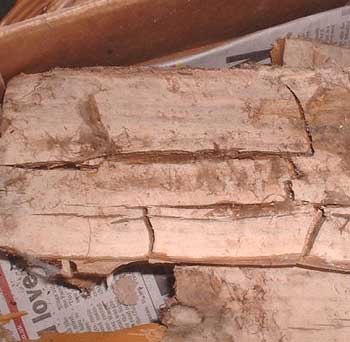
Dry Rot -
large splits, curvature and strands.
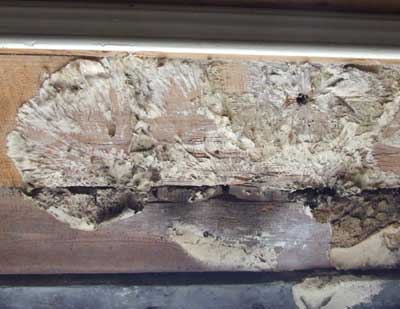
Mycellium
on wood - NOT brilliant white.
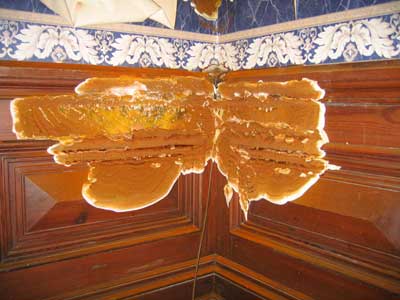
Dry Rot
Sporophore - flat & red rust coloured.
NOT
DRY ROT - THEN IT IS ONE OF MANY WET ROTS
- most commonly misidentified features
1. Coniophora
puteana - the 'cellar fungus' - dark brown to black strands in fern-like
patterns, olive brown fruiting body (rare).
2. Fibroporia
vaillantii - white strands in fern like growths, white fruiting body
with pores.
3. Asterostroma
- brilliant white, fine strands, fruiting body has no pores, mycelium
has tiny star structures, visible only under magnification.

Wet rot -
brown to black strands of Coniophora.
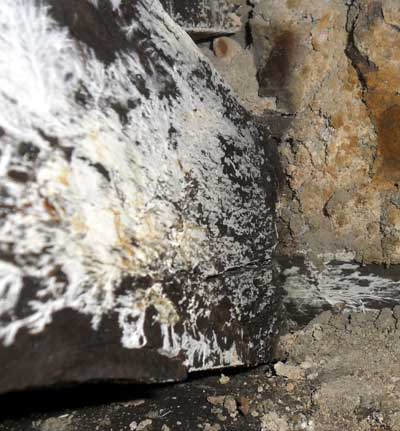
Brilliant
White strands and Mycellium of Fibroporia
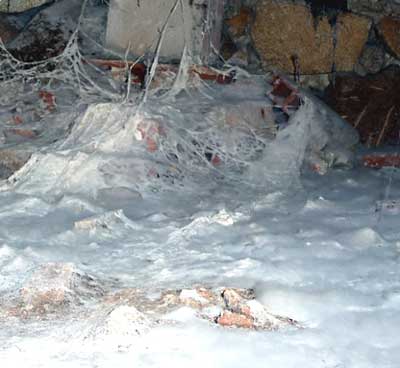
Brilliant
White strands and Mycellium of Fibroporia - both Wet Rots - NOT Dry
Rot.
IDENTIFIED
DRY ROT - Boron treatment
The best,
safest and most pleasant treatment to apply is
Boracol 10 , a water based 'biostat' that has
no adverse effect on non-wood boring insects or mammals (like Bats).
This Boron Products is applied as two or more coats by brush or spray
and soaks quickly into the masonry and any adjacent timber. It is permanent
and, unlike its main rivals, it has no vapour and no smell. It can only
affect wood rotting fungi and wood boring insects, so Bats (a protected
species) are not affected - their main food, the house fly, does not
eat wood and so it never contains any preservative. Heavily infested
areas of timber, and damp patches, should also have an application of
B2 Gel, to reduce the risks of future rot
and provide extra active ingredient. Permanently or seasonally damp
wood needs injection with B40
Injection Gel (for example, window frames,
garden posts, door frames).
The so called
're-entry time', set by the HSE for every Pesticide, is 48 hours or
until dry. Pet birds and fish are not at risk from Boron-based preservatives
when used as specified (minimum of 48 hours r re-entry time, or until
dry)
ADDITIONAL
PRECAUTIONS TO PREVENT THE SPREAD OF DRY ROT - Dry Rot Paint
The photograph
below shows untreated panels, on the left and treated panels on the
right. The treated panels (in two columns) have been painted with Dry
Rot Paint and show no signs of growth!
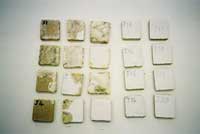
So, you can
further reduce the risk of future Dry Rot attack by using this 'No Go
Zone' special emulsion paint. It can be applied behind skirting boards,
in window frame reveals and in joist sockets. The paint, which has been
tested by BRE (Building Research Establishment - Government backed test
Authority) prevents Dry Rot from passing across treated areas. No other
treatment can currently offer this feature.
If you need
any help with any type of Wood Treatment or identification of wood rotting
fungi Property Repair Systems staff will be pleased to give you completely
free, no obligation advice on 01626 872886 .